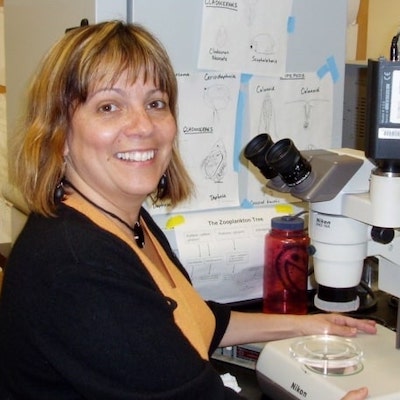
Maria J. Gonzalez
Biographical Information
My long-term research interests have focused on the effects of environmental stressors (acid rain, exotic species, turbidity associated with sediments, eutrophication and herbicides) on aquatic food webs. I am interested in food web interactions and how
environmental stressors can affect such interactions. My research integrates field and lab experiments and comparative field studies. Within this general framework, I have successfully maintained continuous external funding for the following lines of research.
1. Factors affecting food web efficiency:
Food Chain Efficiency (FCE; the proportion of primary production that results in production of the top predator) is a very important ecosystem function that can be affected by autotroph quantity and composition, traits that are linked to the availability of light and nutrients. It is well known that variability in algal carbon and nutrient stoichiometry, fatty acid composition, and digestion resistance can limit the production of herbivores that consume these autotrophs. However, little is known about how constraints at the autotroph-herbivore link propagate to upper trophic levels. Using the mesocosm facility at Miami Ecological Research Center, we have tested the interactive effect of light and nutrients on FCE in two and three trophic level food chains and in pelagic and benthic food webs. These studies show that light and nutrients, via effects on algal quality, can constrain energy flow to upper trophic levels, i.e., carnivores. Currently, my lab is investigating the generality of interactive effects of light and nutrients in FCE. We are interested on how predator identity in terms of nutrient requirements (among-species comparison) and ontogeny (among-species comparison) mediates the effects of light and nutrients on FCE. We also have examined the carryover effects and resulting changes in FCE under different light, phosphorus, and N:P supply ratios (within-species comparison).
2. Factors regulating reservoir food webs:
My lab has collaborated in a long-term study focusing on the factors regulating reservoir food webs, particularly the roles of watersheds and an omnivorous fish (gizzard shad) on these ecosystems. We have analyzed the long-term dynamics of zooplankton communities in Acton Lake and larval fish-zooplankton interactions. Gizzard shad is a widespread omnivorous fish in reservoirs, especially those in agriculturally dominated areas, suggesting a linkage between land use practices and food web dynamics in reservoirs. My long-term data set on zooplankton and larval gizzard shad, in addition to the limnological and hydrological data accumulated by my colleagues (MJ Vanni and WH Renwick), has allowed us to study the response of a reservoir ecosystem to declining nutrient and detritus inputs from the watershed due to improvements in agricultural practices. These improvements have caused substantial declines in phosphorus and suspended sediment inputs to Acton Lake over the last 15 years. Mean phytoplankton biomass (chlorophyll) has increased during this period, apparently due todecreased light limitation resulting from decreased sediment inputs. Our results suggest that in spite of high turnover rates, zooplankton responses to changes in agricultural subsidies lagged behind those of primary producers.
Selected Publications
1. Rowland FE*, SK Tuttle **, MJ Vanni and MJ González. (2016) Canopy cover and anurans: nutrients, not light, are the most important predictor of growth and development. Canadian Journal of Zoology, 94(3): 225-232(DOI: 10.1139/cjz-2015-0022)
2. Showalter AM*, MJ Vanni and MJ González (2016). Ontogenetic diet shifts produce trade-offs in elemental imbalance in bluegill sunfish. Freshwater Biology 61: 800-813, DOI: 10.1111/fwb.12751
3. Rock AM*, MR Hall*, MJ Vanni and MJ Gonzalez. (2016). Carnivore identity mediates the effects of light and nutrients on aquatic food chain efficiency. Freshwater Biology 61 (9): 1492-1508. DOI: 10.1111/fwb.12790
4. Downs KN**, NM Hayes*, AM Rock*, MJ Vanni and MJ González. (2016). Light and nutrient supply mediate intraspecific variation in the nutrient stoichiometry of juvenile fish. Ecosphere 7 (10): DOI: 10.1002/ecs2.1452
5. Connelly SJ, JA Stoeckel, RA Gitzen, CE Williamson, MJ González. (2016). Effect of clonal selection on Daphnia tolerance to dark experimental conditions PLoS ONE 11(7): 1-13 http://dx.doi.org/10.1371/journal.pone.0159628